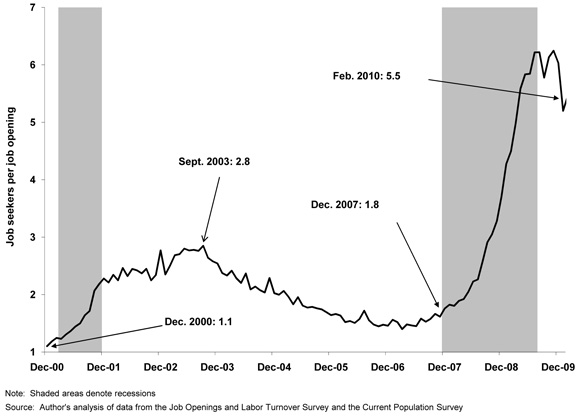This morning, the Bureau of Labor Statistics released the February report from the Job Openings and Labor Turnover Survey (JOLTS), showing that the number of job openings decreased by 131,000 to 2.7 million in February. However, this loss was almost exactly offset by a 130,000 upward revision to January data.
From the Current Population Survey, we know that the number of unemployed workers increased in February to 14.9 million. This means that in February, the ratio of unemployed workers to job openings was 5.5-to-one. This remains a significant improvement over the high of 6.2 job seekers per job opening last November, but is still nearly twice as high as the worst month of the early 2000’s recession, when there were 2.8 job seekers per job opening in September of 2003.

In the first year of the downturn that began in December 2007, layoffs rose and hiring fell, both dramatically. Layoffs reached their peak in the first quarter of 2009, but fortunately have seen substantial improvement since then. The number of layoffs is now back around pre-recession levels. Hiring, however, is not nearly as encouraging. Hiring continued to fall until last summer, and has remained essentially flat since then. Hiring is now around 25% below its pre-recession levels The good news is that layoffs are down to where they were before the recession, and hiring is no longer declining. The bad news is that hiring is nowhere near the levels required to put this country’s 15 million jobless workers back to work. The House and Senate should act to quickly pass the Local Jobs for America Act, sponsored by U.S. Representative George Miller, which is the kind of bold response we need to address this country’s jobs crisis.
For more information on how the current ratio of job seekers to job openings compares to past recessions, visit EPI’s Economy Track.
